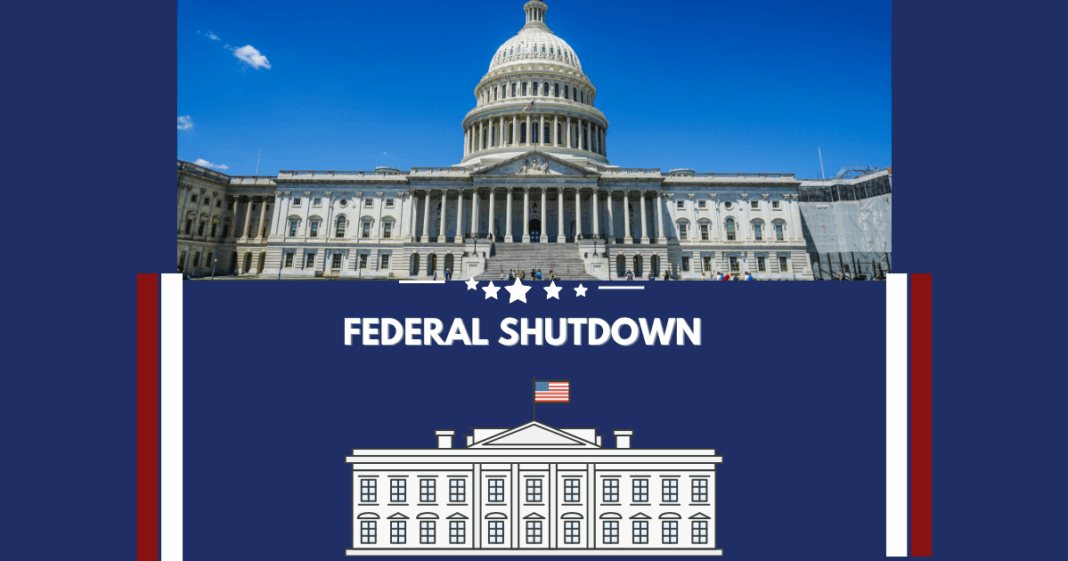A federal government shutdown took effect at 12:01 a.m. ET Wednesday, October 1, 2025, when the Senate was unable to vote for a short-term spending bill. The make-or-break vote for H.R. 5371 fell short of the 60 votes needed, leading to a shutdown of appropriations for the new fiscal year.
Essentially, a shutdown is a budget deficit. When Congress does not enact annual appropriations—or a temporary “continuing resolution”—agencies that rely on annual appropriations must close non-excepted activities under the Antideficiency Act. Activities that are considered essential pertaining to the protection of life and property continue. That framework, refined by Justice Department opinions in 1980–81 and implemented through agency plans, governs each lapse.
How it works in government
Agencies classify workers into three categories. “Excepted” staff perform legally allowed activities during the lapse (but only receive payment once funds are replenished). “Furloughed” employees are not allowed to work. “Exempt” employees are funded via other than annual appropriations (e.g., particular fee-funded accounts) and keep on working and getting paid. At the end of a lapse, back pay for furloughed and excepted staff is guaranteed by the Government Employee Fair Treatment Act of 2019.
What continues
National security and law enforcement continue. The policy of the Department of Homeland Security for shutting down continues its essential “exempt” operations, including border and maritime defense and other public-safety functions.
Air travel continues with points of strain. The Transportation Department’s plan keeps air traffic control and other safety operations operating; certain FAA activities stop or slow based on money available. Industry and agency officials warn delays may occur if staffing is thin.
Social Security and Medicare benefits just continue as usual because they are not funded by annual appropriations, but there could be delays in some customer services. The contingency plan of the Social Security Administration dictates what it will keep doing in case of a lapse.
Mail service remains uninterrupted. USPS is its own self-contained agency supported by stamps and services, and it’s business as usual.
What slows or stops
Operations failing legal “excepted” tests postpone until funding resumes. Numerous normal administrative services, grant processing, and public-facing actions at civilian agencies are postponed under their announced shutdown orders.
National parks typically cut back services. The Interior Department’s National Park Service plan seeks reduced operations and closures based on available fee revenues and on-the-ground safety.
Labor and other home offices use the same contingency playbooks to close non-excepted work with protection of life, property, and records.
Why this shutdown happened
The immediate reason was procedural and numerical: the Senate lacked the 3/5 needed to enact the continuing resolution approved by the House on September 30, without spending authority as the beginning of the new fiscal year ushered in October 1. With neither enacted appropriations nor a CR in place, an automatic lapse in funding results.
What it means for federal employees, contractors, and the public
Excepted employees continue to report to work and are retroactively compensated once a funding bill is signed. Furloughed employees must stop work and receive back pay once the lapse is resolved. Contractors follow contract terms; there is no statutory requirement for across-the-board back pay for contractor personnel. Employees and vendors are to follow their agency’s written notices of shutdown and timekeeping guidelines.
Historical background
Shutdowns do take place, but their scope and length vary. Some notable recent shutdowns involve a 16-day affair in 2013 and a 21-day shutdown during 1995–96. The longest on record lasted 35 days from late 2018 to January 2019, as partial closure reduced economic activity and delayed billions of dollars in federal expenditures, Congressional Budget Office and Congressional Research Service estimate. The ongoing lapse is the first in 2019.
Bottom line
A shutdown is a funding gap, not an interruption of the government. Basic operations continue, most services are suspended, and hundreds of thousands of employees are either furloughed or working without timely pay until Congress enacts a funding bill. To describe program-specific impacts, utilize every agency’s available contingency plan and OPM guidance.
Reference sources:
Reference Sources (inputs from official agencies):
U.S. Senate roll call (H.R. 5371 vote, Sept. 30, 2025): https://www.senate.gov/legislative/LIS/roll_call_votes/vote1191/vote_119_1_00535.htm
OPM — Guidance for Shutdown Furloughs: https://www.opm.gov/policy-data-oversight/pay-leave/reference-materials/guidance-for-shutdown-furloughs-sep-28-2025/
USPS — “Postal Service not affected by a government shutdown”: https://about.usps.com/newsroom/statements/092525-postal-service-not-affected-by-a-government-shutdown.htm
DOT — Plans for Operations During a Lapse in Annual Appropriations (DOT shutdown plan): https://www.transportation.gov/sites/dot.gov/files/2025-09/DOT_Shutdown_Plan_9.30.25.pdf
Social Security — Contingency Plan: https://www.ssa.gov/agency/shutdown/contingency-plan.html
DHS — Lapse in Funding: https://www.dhs.gov/publication/lapse-funding-dhs
A global media for the latest news, entertainment, music fashion, and more.















